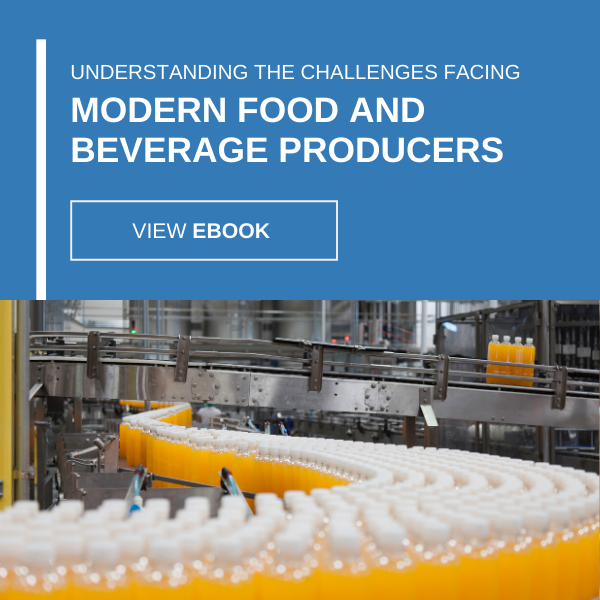
How Food Manufacturers Influence Your Rising Grocery Bills
The rise in food prices is all over the news these days. The USDA and the Consumer Price Index tell us that, in 2023, grocery store purchases were up 5% from the previous year, while eating out cost an average of 7.1% more. This year, those costs are set to bump up another 1.3%. But, if you work in food manufacturing, (or buy groceries for your household) you don’t need the government to tell you those prices are rising.
It’s the trickle-down effect. Challenges facing food manufacturers mean higher production costs, which are ultimately influencing everyone’s grocery bills.
Here’s why, and what food manufacturers can do to save money on the front end to stop that trickle down.
Challenges affecting food prices
Some of the issues food manufacturers are navigating through that can ultimately show up in prices at the grocery store include:
Supply chain disruptions. Whether it’s geopolitical tensions, droughts, wildfires, strikes, or other events, it can disrupt the supply of raw materials food manufacturers use to get the job done. This can and does create delays, backlogs and other costly challenges.
Price inflation. Before price increases hit the grocery store shelves, the rising cost of things like grain, meat and dairy affects manufacturers who use those raw materials to make their goods.
Shipping costs. Rising fuel prices affect how much it costs to get those raw materials to food manufacturers, whether it’s coming from across town or across the world.
Labor shortages. The continuing battle to hire and train good people, and retain the ones you have, contributes to labor costs at the plant, which contributes to rising costs for the end user.
Evolving demand. Consumers are ever changing in their preferences and expectations. People are increasingly demanding sustainability, ethical sourcing, friendly practices like free-ranging and more. And dietary trends shift too, with plant-based alternatives growing in popularity on the one hand and minimally-processed meals on the other. This makes it difficult for manufacturers to forecast to accommodate the demand.
Regulations. Compliance with FDA regulations can be complex at best and lead to inefficiency and higher costs for manufacturers at worst. It’s especially prevalent in yield, when manufacturers are trying to hit the “wiggle room” the government allows between what the package label says and how much product is actually in the package. Not wanting to be out of compliance, manufacturers often overfill packaging to reach that sweet spot, but it means they’re actually giving away product… and profits.
All of these challenges can have a direct impact on manufacturing costs and will inevitably trickle down to their customers. It boils down to:
Higher production costs. This is by no means unique to the food manufacturing industry. Higher production costs on things like raw materials, labor, transportation and more mean higher costs to the customer – that’s a fact of life for most every business.
Supply and demand uncertainty. Supply chain disruption leads to shortages, which cause prices to rise.
How food manufacturers can tackle these challenges
In the short term, agility is key. But strategic planning, process improvements, and a focus on efficiency can shore up food manufacturers for the long run.
Sales, Inventory & Operations Planning which we call SIOP, takes the sales and operations planning (S&OP) process that most manufacturers use and adds inventory to the mix. At USCCG, we find inventory is often left out of the planning process, but it can be as important of a variable and a strategic tool. Following this methodology helps manufacturers eliminate waste, increase efficiencies and achieve an optimal level between not enough and too much.
It’s also an unparalleled tool for inventory management, which is a tricky business today given all of the challenges this industry is facing.
If you would like to learn more about SIOP, download our (free) eBook, “Sales, Inventory & Operations Planning: It’s About Time.”
Process improvements. One way streamlining and refocusing your processes can help manufacturers now is in the area of yield. Getting a handle on yield — improving processes so you’re not giving away product — can save millions of dollars. To learn more about how one food distributor saved $2.3 million per year by improving their yield, read “Food Distributor Masters Management by the Numbers to Improve Yield.” And speaking of management by the numbers…
Implement a Solid Management Operations System. Many manufacturers, whether food or other industries, tend to manage on the basis of what has worked in the past, a gut feeling by seasoned managers, and other methods. At USCCG, we like hard numbers, streamlined processes and everyone doing the same job the same way. And about that…
Focus on training. It’s crucial to have all shifts, all facilities and all employees working in tandem, doing the same job the same way. It’s how you create the proverbial well-oiled machine.
None of these tactics will stop challenges from happening, but they can and do make your operations more efficient, and in turn, save you money. Not only will it improve your bottom line, but you might just be able to trickle the savings down to your customers, too.







